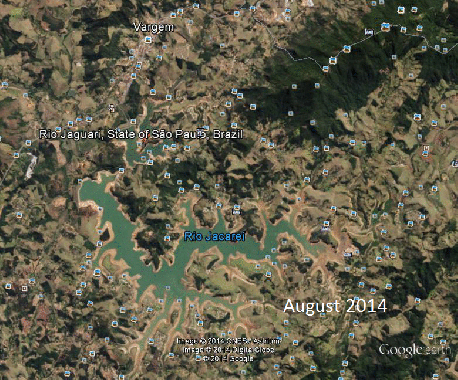There’s a drought in São Paulo that could dry up the money you’ve set aside for your daily brew. I made this GIF with a free gif-maker online about the reduced water levels of Río Jarguai in São Paulo, based on a report by NASA.
Production
Which Coffee, Where?
To grow coffee is a feat in itself. To grow anything with consistency at all, in fact, is a life-consuming endeavor. Agriculture is often romanticized by urbanites (such as myself) who know nothing of the realities of farm life and have never maintained more than three lettuce plants…which aren’t doing so well, because I don’t water them enough. The excellent people who make a living growing what we eat are deeply involved not only in the organisms they cultivate, but also the environment in which they are grown – the altitude, soil, rain, topography, temperatures, pests and pathogens.

A coffee plant with both ripe and unripe cherries in Honduras, its leaves afflicted by coffee rust. Probably arabica. Photo Credit: Unión Microfinanza, Honduras
I did promise a post about coffee rust, a fungus that has dealt and continues to deal powerful blows to coffee producers, particularly in Latin America. But even before we go there, the first crucial question for the urbanites is: since we’ve talked about the coffee plant, how many kinds are there? Here I’ll address the ‘where’ and ‘what’ in the title. The ‘who’ is for another time, that’s a topic for which I will cover in greater detail in the future.
If ‘kind’ is taken to mean species, the short answer is two. The two most-grown coffee species in the world are arabica and robusta (Coffea arabica and Coffea canephora). In general, arabica makes up two-thirds of coffee grown globally and is what goes into that espresso shot; it’s native to Ethiopia. Arabica is grown in the full-sun for export by coffee powerhouse Brazil, and in shade by small-scale producers in Guatemala, El Salvador, Costa Rica and other Central American countries. Robusta – which goes into Folger and Nestlé’s soluble instant-coffee crystals – is grown by Vietnam (the other coffee powerhouse), Brazil in smaller quantities, India, Indonesia and Uganda, to name a few.
The long answer is: about eight, because other species of coffee matter as well – despite the fact that they’re not grown commercially. For coffee geneticists, three other species of coffee (C. eugenioides, dewevrei & stenophylla) are important not because they make a delightful brew (they don’t) but for their drought-, pest- or pathogen-resistant genes, which can then be used to modify that of the valuable arabica. Another three species of coffee are cultivated for smaller markets in Vietnam and Mozambique.
To augment the long answer to make an even longer answer, within two main species arabica and robusta exist a whole list of cultivars, hybrids and mutants that are differentiated within the industry. To see a nice pictorial representation of this by Café Imports.
But that is another post.
Thanks for reading. I hope you are having a good weekend and enjoying your drink of choice – cup of coffee, tea, hot chocolate, whiskey (who knows).
Do comment/share if you enjoyed what I’m writing about here on BeforeTheBean. Even better if you have suggestions on what else I should write about.
Sources:
Statistics from the International Coffee Organization (1), coffee factoids (2, 3), photo credit (4)
